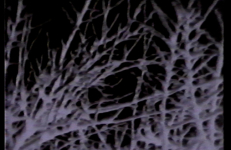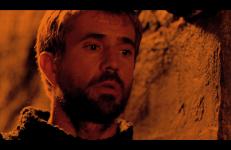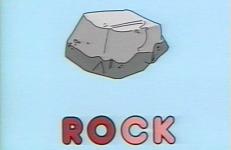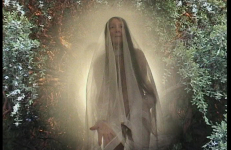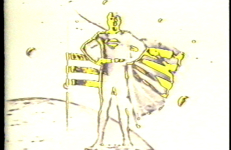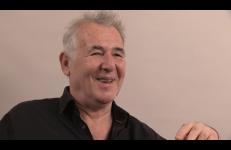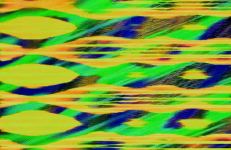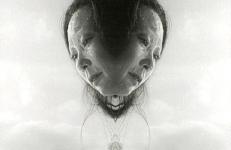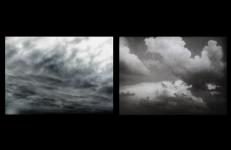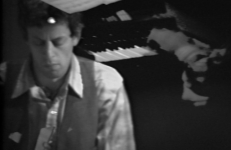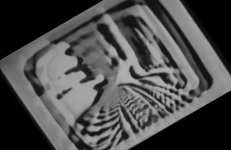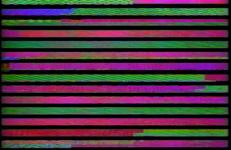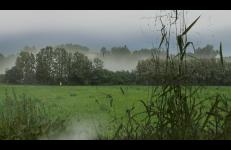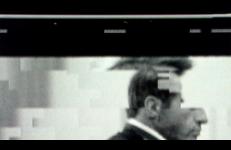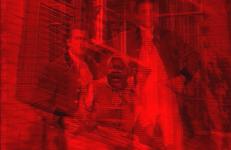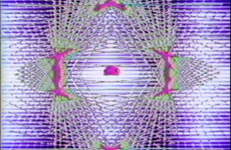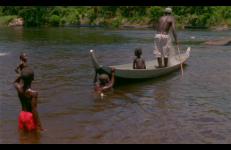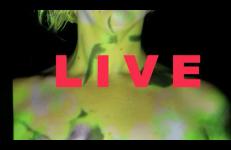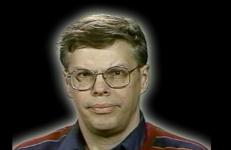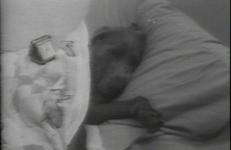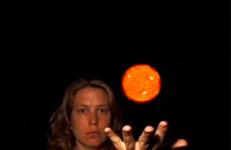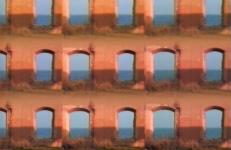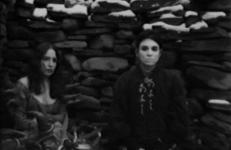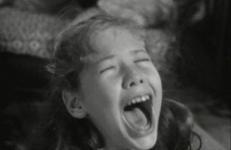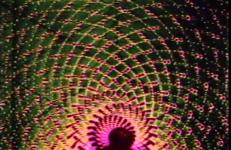In Mute, fragmented images of the female body, recalling sensuous landscapes, suggest the objectification of women in a culture that renders them silent.
Image Processing
Nine Hamlet RGB engages a simple algorithm to destabilize the timing of the red, green and blue frame sequential display system while incorporating fragmented, appropriated “to be or not to be” excerpts from nine Hamlet films. The audio is the synced sound from the appropriated excerpts laced with low frequency binaural tonal pulsations. The physicality of the constructed optical and aural experience is seeking a mechanism of unconscious disarticulation.
"A trance is a state of detachment with aspects of the ecstatic. Paradoxically, a trance can be induced by a surfeit of input or by its deprivation... In Anthony Discenza's Object 8242600, television imagery is reduced to a flood of unanchored signifiers reorganized as a motive mosaic."
—Steve Seid, Pacific Film Archive
‘ODDS AND ENDS’ is a dazzling patchwork of moods, lost and found, for the eye to savor.
In Ontogenesis, Tanaka interweaves electronically altered images of American patriotism–the Statue of Liberty, Uncle Sam, waving flags–with footage of the Vietnam war, bombs dropping, and 1960s political figures (L.B.J. and J.F.K.) to chronicle the progress of American nationalism in the space/nuclear age.
A password-protected love affair, a little vapor on Venus, and a horse with no name ride out in search of a better world. Against the mounting darkness, a willing abduction offers a stab at tomorrow.
Please note that strobe effects are used in this video.
A video recording of electronic oscillators producing colors, shapes, and sounds while patched through a computer and/or producing one or several feedback loops.
Oscillator Color is also available on Gruffat's Video Animations compilation.
By subjecting fragments from the Akira Kurosawa’s film Rashomon to a mirror effect, Provost creates a hallucinatory scene of a woman’s reverse chrysalis into an imploding butterfly. This physical audiovisual experience produces skewed reflections upon Love, its lyrical monstrosities, and a wounded act of disappearance.
The four‐part cycle Parallel deals with the image genre of computer animation. The series focuses on the construction, visual landscape and inherent rules of computer-animated worlds.
“Computer animations are currently becoming a general model, surpassing film. In films, there is the wind that blows and the wind that is produced by a wind machine. Computer images do not have two kinds of wind.”
-- Harun Farocki
Philip Glass, a pioneer in minimalism in music, gave a two-day lecture at the School of Art Institute of Chicago in 1974. In musical composition, minimalism highlights the repetition of melodic fragments, harmonic progressions, rhythmic structures, etc. Glass’s music is often steady in terms of volume and tempo, then, when introducing slight alterations, the pattern changes become notably audible.
“Video is a fugitive medium,” said Getty Research Institute’s Glenn R. Phillips, and he should know. As curator for California Video, a 2008 at the Getty Museum, he enjoyed the luxury of a massive archive produced during the 1960s, 70s and 80s. Most of the tapes, recorded in obsolete formats, were crusted with oxidation, making the work unwatchable and threatening to ruin any deck that would play them. Jonathan Furmanski, an Assistant Conservator at the Institute, describes one particularly unruly video installation, Philo T.
Broken up into "chapters," Phosphoresence features an array of abstractions created by manipulating television images. At times almost painterly, the resulting images are set to an ambient electronic soundtrack.
This title is also available on Anthony Discenza Videoworks: Volume 1.
A man with two dogs crosses a landscape. A person walks along a ridge and stops to look at the skyline. Other people run while nature shrinks back to its enigmaticness. In this video landscape doesn’t evolve according to simple time curves, but according to the particular mode of crossing of a weather element: fog.
In a celebrity-obsessed culture, filmmakers often exploit the downfall of a star to amplify the emotional undertones of the fictional films in which they perform. POSTFACE takes a look back at the filmography of Montgomery Clift whose private life and career spiral downward after a 1956 car crash that left his face scarred and partially paralyzed.
Note: This title is intended by the artist to be viewed in High Definition. While DVD format is available to enable accessibility, VDB recommends presentation on Blu-ray or HD digital file.
Red Green Blue Gone with the Wind is a phosphorescent deconstruction of David O. Selznick's Technicolor classic Gone with the Wind (1939). Through the structural devices of condensation, the frame-by-frame separation of the red, green, and blue Tehnicolor layers, and the de-interlacing of the video field, LeVeque presents a destabilized illumination of the relentless romantic nostalgia for the antebellum past.
This title is also available on Reconstruction Trilogy: Les LeVeque.
Video from the 2nd Interactive Electronic Visualization Event (IEVE), a collaboration event with SAIC's Video Department and the University of Illinois Circle Campus. Rescanning of IEVE, edited by Phil Morton, includes documentation of the event, video of the artists using the Sandin Image Processor and other synthesizing equipment, and the video and sound created by the artists.
Image Processing by Phil Morton, Audio Synthesis by Bob Synder, Image Generation by Gunter Tetz.
“Animists are people who recognise that the world is full of persons, some of whom are human, and that life is always lived in relationship with others.”
-- Graham Harvey, Animism
Trance dance and water implosion, a kino-line drawn between secular freak-outs and religious phenomena. Filmed in a single take at a sacred site on the Upper Suriname River, the minor secrets of a Saramaccan animist's everyday are revealed as time itself is undone. Rites are the new Trypps -- embodiment is our eternal everything.
Proposal for sidewalk projection in NYC using 7+7. Performed by Heidi Wiren Bartlett.
Security Anthem’s requisite components came together relatively slowly. I’d known for years that I wanted to make something out of the Oto speakers’ most sinister, suggestive sentences. I’d taught myself to program music on a Game Boy using a cartridge I’d bought from a Swedish programmer, and I composed a sequence of ominous music that seemed well-matched to the speakers. I’d recorded John Ashcroft singing his self-penned song “Let the Eagle Soar” through a media player window, and I knew that it somehow belonged with the speakers and the 8-bit music.
Originally recorded during 1975-76 and re-mastered in March 2005, this selection of 11 skits mostly focuses on Man Ray. Wegman appears to test his faithful friend, continually throwing a ball for him to catch even after the dog loses enthusiasm; playing with a cardboard tube which intermittently emits a loud sound recording, alternately attracting and repelling the dog; pulling a cord attached to his leg while making him “stay”. Wegman also take a leap into the world of color with special effects and a monolog about furniture. Includes:
Small Miracles is a suite of eight video animations in which the artist conjures up and controls forces of nature. Ignoring rational constructs of what is possible, Hechtman creates imaginary works to ground science fiction in the everyday experience. Coupling feminism and natural phenomena, the videos are located in the liminal space between fantasy and the everyday.
An example of what Reeves terms “video poetics,” layered images of a deserted village in the Spanish countryside play counterpoint to poetry by Cesar Vallejo and Pablo Neruda. Using slick production techniques, Reeves marks the passing of time and human presence with a video transparency effect. What we see is a ghost of what was. Reeves’s precise editing makes for an extraordinarily fluid tape, as images seem to fly through the landscape, through past, present and future.
A Japanese Kabuki-influenced performance piece, shot in the woods in Winter. A masked woman emerges from a snowy forest and approaches a stone dwelling, where another woman is waiting. The pair enact a tea ceremony in silence.
In the next scene the tea tray appears in the road, and then disappears after a car passes. Image processing magic.
Please note, production year is approximate.
In Spank an eight-second film clip has been re-edited, frame by frame, into a 7 1/2-minute video, tranforming discreet gestures into suggestive, pulsating sequences. This deconstruction of narrative Hollywood cinema exposes and intensifies the authoritative relationship between a man and a young girl.
Short for "Probably The Last" (of the series), Spiral PTL uses the image processor like a musical instrument to create variations on a spiral, transforming its basic form into an ever-moving gyro. The movement is synchronous with an audio track that varies from electronic buzzes and Space Age voices to the quiet sounds of running water.




